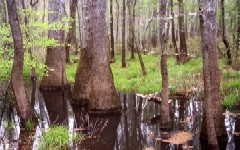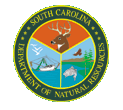South Carolina GAP Analysis

GAP is a national program which brings together the problem-solving capabilities of federal, state, and private scientists to tackle the difficult issues of land cover mapping, animal habitat characterization, and biodiversity conservation assessment at the state, regional, and national levels. It is administered by the U.S. Geological Survey Biological Resources Division through grants to state cooperative fish and wildlife research units at the 50 land grant universities. For the State of South Carolina, the Cooperative Research Unit is located at Clemson University.
Mission of GAP
The mission of the GAP Analysis Program is to prevent conservation crises by providing conservation assessments of biotic elements (plant communities and native animal species) and to facilitate the application of this information to land management activities. This is accomplished through the following five objectives:
- Map actual land cover as closely as possible to the alliance level (FGDC 1997).
- Map the predicted distribution of those terrestrial vertebrates and selected other taxa that spend any important part of their life history in the project area and for which adequate distributional habitats, associations, and mapped habitat variables are available.
- Document the representation of natural vegetation communities and animal species in areas managed for the long-term maintenance of biodiversity.
- Make all GAP project information available to the public and those charged with land use research, policy, planning, and management.
- Build institutional cooperation in the application of this information to state and regional management activities.
To meet these objectives, it is necessary that GAP be operated at the state or regional level but maintain consistency with national standards. Within the state, participation by a wide variety of cooperators is necessary and desirable to ensure understanding and acceptance of the data and forge relationships that will lead to cooperative conservation planning. Cooperating agencies in the SC GAP include the U.S. Geological Survey, U.S. Fish and Wildlife Service, U.S. Forest Service, U.S. National Park Service, S.C. Department of Natural Resources, S.C. Forestry Commission, Clemson University, College of Charleston, and University of South Carolina.
Limitations
Limitations must be recognized so that additional studies can be implemented to supplement GAP. The following are general project limitations:
- GAP data are derived from remote sensing and modeling to make general assessments about conservation status. Any decisions based on the data must be supported by ground-truthing and more detailed analyses.
- GAP is not a substitute for threatened and endangered species listing and recovery efforts. A primary argument in favor of GAP analysis is that it is proactive: it seeks to recognize and manage sites of high biodiversity value for the long-term maintenance of populations of native species and communities before they become critically rare. Thus, it should help to reduce the rate at which species require listing as threatened or endangered. Those species that are already greatly imperiled, however, still require individual efforts to assure their recovery.
- GAP data products and assessments represent a snapshot in time generally representing the date of the satellite imagery. Updates are planned on a 5-10 year cycle, but users of the data must be aware of the static nature of the products.
- GAP is not a substitute for a thorough national biological inventory. As a response to rapid habitat loss, GAP analysis provides a quick assessment of the distribution of vegetation and associated species before they are lost, and provides focus and direction for local, regional, and national efforts to maintain biodiversity. The process of improving knowledge in systematics, taxonomy, and species distributions is lengthy and expensive. That process must be continued and expedited, however, in order to provide the detailed information needed for a comprehensive assessment of our nation's biodiversity. Vegetation and species distribution maps developed for GAP can be used to make such surveys more cost-effective by stratifying sampling areas according to expected variation in biological attributes.
Program Objectives
The SC GAP project began in 1996 as an effort of the South Carolina Cooperative Fish and Wildlife Research Unit. Partners in the project from the beginning included the South Carolina Department of Natural Resources and the US Fish and Wildlife Services Coastal Ecosystems Project. There were six objectives defined for the project:
- Map the vegetation of South Carolina in as much detail as possible with the goal being the production of a land cover map easily cross-walked to the TNC alliance level, which is dominant species.
- Produce a database of vertebrate ranges and habitat affinities for use in predicting vertebrate distributions within the state.
- Produce a database of protected lands within the state including both public and private agencies with associated ownership data and to to classify them by protection status.
- Analyse the relative protection of the state's biodiversity through a GAP analysis.
- Build partners during the development and implementation stages of the SC-GAP projects.
- Provide scientific data on the state of South Carolina's biodiversity to the managers and decision-makers of the state of South Carolina.
Product Overview
The following GAP products are available through this website.
- Land Cover: Maps the state's natural and man-made vegetation types in 27 classes.
- Species Distributions: Shows the predicted distributions of 455 vertebrate species.
- Species Richness: Identifies and highlights rich-areas in terms of number of species.
- Stewardship:> Displays stewardship lands with the information of ownership, GAP status, and land cover types.
- Tables of Analysis: Summarizes the results of two analyses to show the area (sq. km) of each land type or species habitat by land steward and GAP status.
- GAP Report: The final project report delivered to the National GAP.
Outreach of SC GAP
The outreach portion of the project has been very successful through partnerships developed during the accomplishment of our goals. These partnerships will continue through activities such as finer scale mapping of state natural land covers, scientific studies of invertebrate diversity, better habitat modeling and through ongoing land cover and change detection projects. For the end-users within the state, a closeout reception for the SC-GAP project was held in December 2001. Posters of GAP products were displayed, and information was disseminated about future directions. Requests are already coming for the data and the displays from the meeting. There are many committed and excellent land managers, planners, agency personnel and conservation groups that are interested in the data, and it is our hope that they will take it, use it, and make it better.Purchase Data CD
The data CDs contain the project report and final products which were created by SC GAP and delivered to the National GAP. To purchase CDs, please contact Dr. Craig Allen, the leader for the South Carolina Fish and Widllife Research Unit at Clemson University via email: allencr@clemson.edu or at the address: C.R. Allen, SC Cooperative Fish & Wildlife Research Unit, G27 Lehotsky Hall, Clemson University, Clemson, SC29634.



